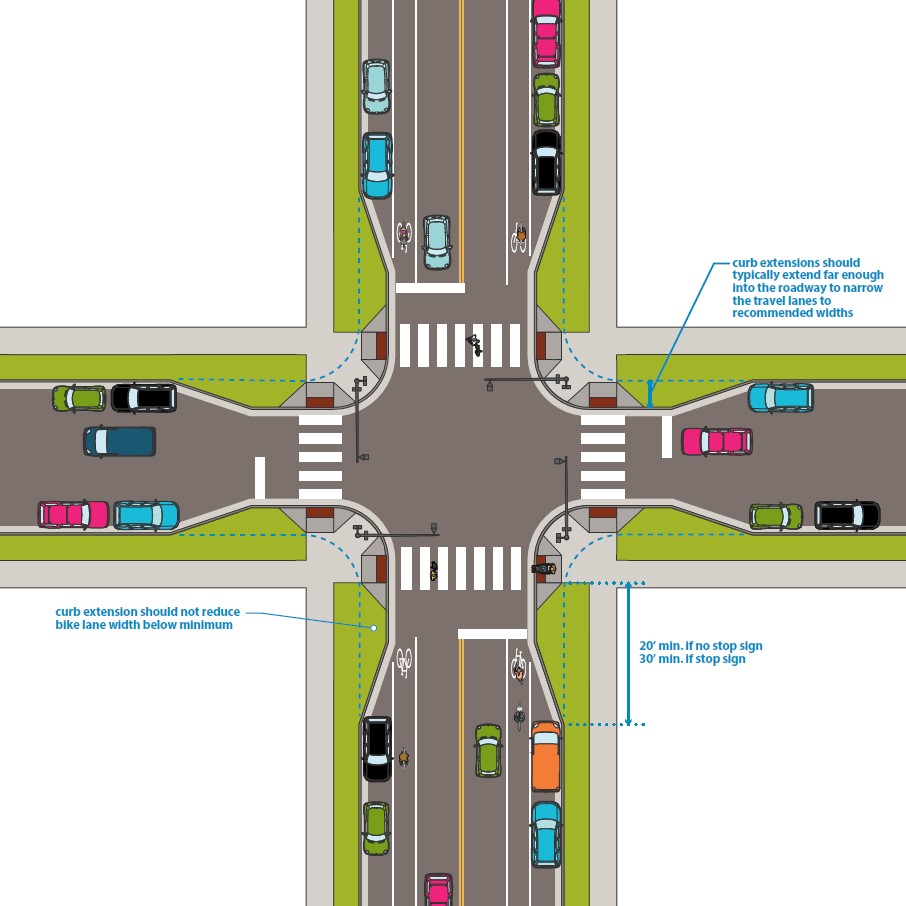Curb extensions, also known as bump outs, are an extension of the sidewalk zone or curb line into the roadway zone at intersections or mid-block locations.
Introduction
Curb extensions, also known as bump outs, are an extension of the sidewalk zone or curb line into the roadway zone at intersections or mid-block locations. Curb extensions are intended to increase safety, calm motorized traffic, and create additional space for pedestrians and the boulevard and furnishing zone.
Curb extensions provide the following benefits:
- Improved sightlines between vehicles and pedestrians.
- Reduced pedestrian crossing distance, thereby reducing pedestrian exposure to potential vehicle conflicts.
- Additional pedestrian queuing space before crossing.
- Can slow vehicle turning speeds by decreasing turning radii and visually narrowing the roadway.
- Additional corner space to fit two perpendicular curb ramps per corner, utilities and traffic control, furnishings, greening, transit facilities, bicycle parking, and sidewalk cafes.
- Additional pervious space for green stormwater infrastructure.
- Restrict cars from parking too close to the intersection and inhibiting sightlines.
Figure 3.7D.3:
Curb extensions

Design Considerations
|
Location
|
- Curb extensions should generally be used at all intersections where full-time parking lanes are present or excess travel lane width is present.
- Exceptions include intersections where pedestrian and bicycle safety islands or medians are preferred, Urban Neighborhood streets where a traffic circle is preferred, and Production and Processing streets where they should be considered but may not be appropriate given the frequency of large trucks.
- Curb extensions may extend into one or multiple legs of an intersection depending on the configuration of parking lanes.
- Curb extensions can also be used midblock to support additional greening and traffic calming or for midblock pedestrian crossings.
|
|
Width
|
- Curb extensions should typically extend far enough into the roadway to narrow the travel lanes to recommended widths (see lane widths guidance).
- The gutter of the curb extensions should be outside of the vehicular travel lane and should not reduce bike lane width below the constrained minimum (see bike lane width guidance).
- With a typical 8’ parking lane on a street with recommended lane widths, the curb extension would be 6’ wide. Curb extensions should be a minimum of 3' wide.
- Curb extensions should not reduce the curb-to-curb width to less than 13’ to ensure emergency vehicle and winter maintenance vehicle access. Coordinate with Fire Department if narrowing curb-to-curb width to 14’ or narrower.
|
|
Tapers
|
- A 5:1 taper (5’ of length for every 1’ of width adjustment) is preferred for curb extensions. In areas with high parking demand and/or parking meters, a 3:1 taper can be used.
- Avoid placing driveways in a curb extension taper when possible.
|
|
Length
|
- Curb extensions should generally be at least long enough to support no parking in restricted parking areas (see parking and intersection visibility guidance). A typical 6'-wide curb extension (including the taper) should generally be at least 18’. This minimum is based on 3:1 minimum taper.
- Longer curb extensions may be desired, depending on needs for greening, transit stops, sidewalk cafes, other furnishings, or snow storage. Designers should balance those needs with right-sizing the amount of on-street parking when determining the length of curb extensions.
- In areas with metered parking, designers should discuss the available parking area with parking staff to ensure that curb extensions match well with spacing for metered parking. The exact length of curb extensions should be set to avoid leaving extra space beyond the metered parking that might attract illegal parking.
|
|
Turning Movements
|
- The turning movements of design and control vehicles should be considered when designing new curb extensions; see design and control vehicle guidance for additional information.
- When curb extension locations conflict with necessary turning movements, consider reducing curb extension dimensions before eliminating.
|
|
Curb Ramps
|
Where possible, design curb extensions to fit two perpendicular curb ramps aligned with the sidewalk and crosswalk.
|
|
Bikeway considerations
|
- Curb extensions may complicate the installation of future bike facilities and should be designed and implemented with consideration for the existing and proposed AAA bike network.
- Curb extensions may be constructed or retrofitted to transition on-street bikeways from street to sidewalk-level behind the curb by employing bicycle-specific slip ramps up and down stream of the intersection. This should be prioritized when rebuilding signalized intersections or quadrants along AAA bike routes with existing on-street bike lanes.
- On neighborhood greenways: bicycle boulevards where bikes travel in mixed flow with vehicles, curb extensions should not force cyclists to merge unexpectedly with cars at the end of the block.
- See protected intersection guidance and bus stop and bikeway guidance for additional details on curb extensions in these cases.
|
|
Sightlines and pedestrian clear zone
|
Street furniture, trees, plantings, or other amenities included in the curb extension area should not impede sightlines or redirect the pedestrian clear zone at intersections. See sidewalk visibility guidance for more details.
|
|
Maintenance
|
Curb extensions need to be carefully designed to drain properly and to avoid ice, leaf, and road debris buildup, especially if there is not a catch basin at the corner. |
|
Drainage
|
Curb extensions may impact existing catch basin locations, underground utilities, and curbside uses. And they may require additional catch basins if there is not currently one. These impacts should be evaluated during the scoping process as they may increase costs significantly. |
|
Transit
|
For transit related curb extension design considerations, please reference transit stops. |
|
Delineator curb extensions
|
Low-cost curb extensions can be implemented using delineators in street retrofit project. See detailed guidance here.
|




